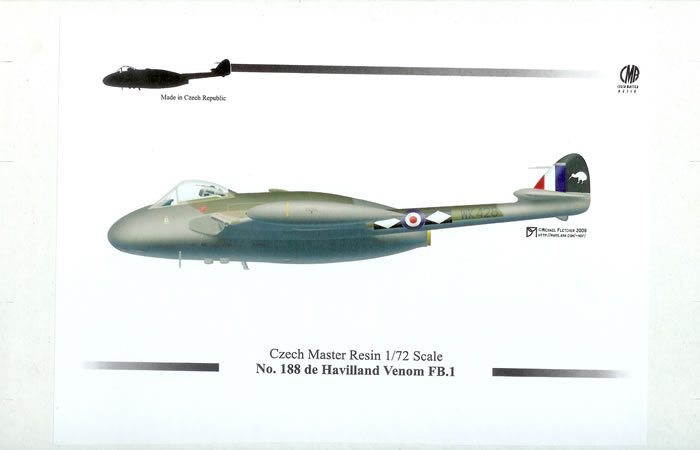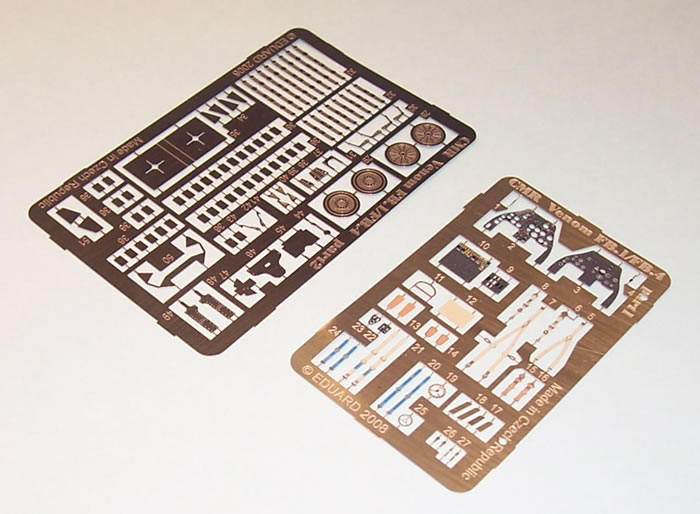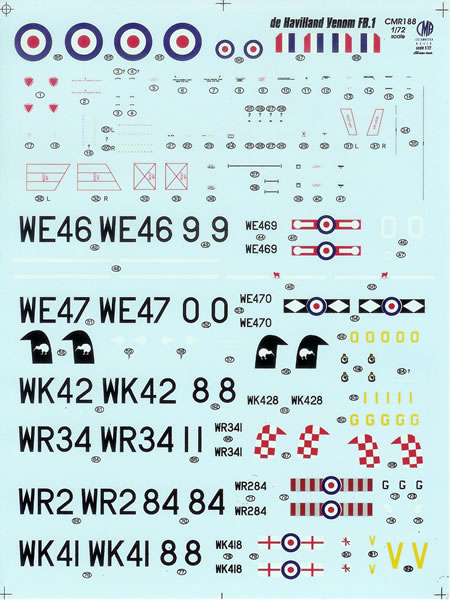|
de Havilland Venom FB.1

Czech Master Resin, 1/72 scale
S u m m a r y : |
Catalogue Number: |
Czech Master Kit No. 188 - de Havilland Venom FB.1 |
Scale: |
1/72 |
Contents & Media |
123 x cream resin airframe parts, 7 x black resin undercarriage parts, 1 x Eduard coloured photo-etch (PE) fret of 34 parts, 1 x plain PE fret of 83 parts, 2 x vac-from acetate canopies & 1x Eduard pre-cut mask |
Price: |
Available online from Hannants for £28.69, Red Roo Models for Au$65.00, Westcoast Hobbys for Cn$49.00 and various other CMR stockists. |
Review Type: |
First Look |
Advantages: |
Highly detailed and very comprehensive kit. |
Disadvantages: |
|
Conclusions: |
The definitive DH Venom in 1/72 scale. Suited to modellers with some resin and multi-media experience. A superb kit. |
Reviewed
by Mark Davies

HyperScale is proudly supported by Squadron.com
The Venom was a logical development of de Havilland’s Vampire, and was originally going to be designated the Vampire 8. However the use of a more powerful Ghost engine, and thinner wing with slightly swept leading edge led to the adoption of a new product number of DH 112, and it was named Venom. Early development problems led to a number of modifications and refinements. Perhaps the most important change for pilots from the Vampire was the installation of a Martin Baker ejector seat in all but the earliest Venom FB.1’s.
Unlike its Vampire predecessor, the Venom displayed a useful ability in the high altitude interceptor role and was quite maneuverable at high altitude. But just like the Vampire, it excelled as a fighter-bomber where its stability as a gun platform and low-level maneuverability basically outshone all-comers. This capability was to be further enhanced with the introduction of the Venom FB.4.
Introduced to service in 1952, the Venom must really be considered to still be a first generation jet as far more advanced types like the F-86 and MiG-15 were by then entering service. Despite this, both fighter-bomber versions of the Venom were to see extensive operational use during the1950’s, usually in counter insurgency roles in places like Malaya (Malaysia) against communist guerillas, in Kenya against the Mau Mau, and also Aden and Oman. They also served in a more conventional war setting during the Suez crisis when attacking Egyptian targets. The last RAF Venoms were retired in 1962.
Fighter-bomber versions of the Venom were also operated by the New Zealand, Venezuelan and Swiss air forces (the Swiss retiring theirs in 1983). Twin-seat Venom developments served as night fighters and all-weather interceptor for naval use in the form of the Sea Venom. These radar equipped Venoms were widely exported.
I have a copy of the very good Rareplanes Venom FB.4 vac-form, and am aware of Aeroclub’s FB.1 and FN.4 kits that were limited run styrene with white metal detail parts. It is also possible to kit-bash Frog’s nice Sea Venom with a Vampire to get a Venom single-seat fighter-bomber. But by any measure, a really good 1/72 scale kit of a single seat Venom is long overdue.
Before proceding I must declare a minor involvement at the research stage of the CMR Venom FB.1 kit, as this is acknowledged under credits in the instructions. I provided some archival material and served as a link for CMR in their dealings with the RNZAF Museum when obtaining photographs and airframe stencil information.
Unlike previous CMR kits of this size and type, the kit comes packaged in a sturdy top opening box rather than the more usual end-opening type. I’m sure that this will be welcomed by most modellers who like to use the two box halves as parts trays when building.
The parts and decals are in heat sealed plastic bags, which in turn are sealed in a further bag with the instructions and photo-walkaround. The straightforward instructions consist of three double-sided A4 pages. The parts map and constructional illustrations are very clear and easy to follow. A further three double-sided pages gives comprehensive colour plans, whilst another illustrates the airframe stenciling. Detailed colour notes and other written instructions are in English. Two more double-sided pages provide an excellent photo walkaround focused on various detail aspects of the aircraft as well as some in action shots, along with a single sided page providing the aircraft’s history in brief.
The kit’s resin parts are in CMR’s usual cream resin, and very nicely moulded with minimal presence of pinholes (and then only on the thick edge of the fuselage halves where they can easily be dealt with). A little flash is evident on the leading edges of the wings, but this can be removed easily and in seconds.
A choice of cockpit interiors is provided, with two different floors and rear bulkheads to complement either the fixed or ejector seat equipped versions. Both seats are enhanced by the use of pre-coloured Eduard PE belts, and in the case of the ejector seat, pre-colored firing handle and foot rests. A lot of cockpit detail is moulded onto the interior walls of the fuselage halves, some of which are to have pre-coloured PE details attached, and is rounded out by a pre-coloured PE instrument panels and a resin gun-sight.

Unlike their earlier Vampire kits, where the fuselage was split horizontally with the top half incorporated into the wing, CMR has chosen to split the fuselage vertically with separate wings. The inlets are also separate from the wing and have achieved some good depth. The twin booms and horizontal stabilser will need some careful alignment, but the plug and socket fit CMR has engineered will aid this. Very detailed flap and main undercarriage bays beg for careful painting, as does the nose-wheel bay. The undercarriage is rounded out with some very fine undercarriage doors and black resin undercarriage legs. This latter medium provides greater strength than the cream resin for fine weight-bearing parts.
The kit is awash with fine detail and some parts like the cannon barrel tips and ammo-link ejector chutes are tiny. Considerable attention to detail has been paid, with small bottles to be fitted in the flap bays, separate tiny leading edge slats, optional tip-tank fins for early versions and so on. Special mention should be made of the engine exhaust which has some intricate detail moulded inside and quite deep within its length.
The under-wing weapons option include1,000, 500 and 250 lb bombs, and four types of rocket. These last being 25 and 60 lb warhead versions with each of their concrete head practice equivalents. The rockets offer some real promise for realism. They consist of a resin warhead and motor/body (some will require gentle straightening using warm water), with the option of fitting either rein or PE fins. If the latter and most realistic option is chosen then construction will be aided by a small PE jig that serves to align the PE fins at 90-degree intervals. PE parts serve as the spring-loaded clamps that suspend the rockets beneath the launch rails and each other, and achieve further realism due to their finesse. Detailed painting notes are included for all weapons. AS an aside, the weapons account for 54 resin and 53 PE parts.
I’ve already mentioned many of the parts from the two PE frets. However I should also mention that they also provide such things as trim wheels, a choice of wheel hubs, oleo torque links, undercarriage reinforcing plates, head armour for fixed seat version and so on.
Two vac-from acetate canopies provide for insurance or practice when cutting out.

They come with An Eduard pre-cut mask which simply serves to make life easy when it comes to painting.

Decals are typical of CMR, being well registered and suggest good opacity. Based on past experience they should be very good to use; but like most Czech decals they will be quite thin and need to be floated into position, as they tend to adhere extremely well once there is no fluid under them. Markings for three RNZAF and three RAF schemes are included, several of which are quite colourful.
This is a superbly executed kit of a rather overlooked but deserving subject. Despite its tiny details and high parts count it should go together in a straightforward manner.
CMR Models are available
online from Hannants in the UK,
Red Roo Models in Australia
and
quality specialist model retailers worldwide.
Text Copyright © 2009 by Mark Davies
This Page Created on 11 March, 2009
Last updated
11 March, 2009
Back to HyperScale
Main Page
Back to Reviews
Page
|
